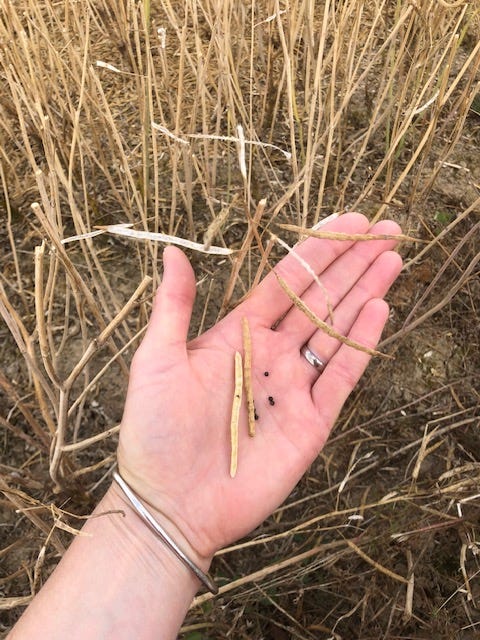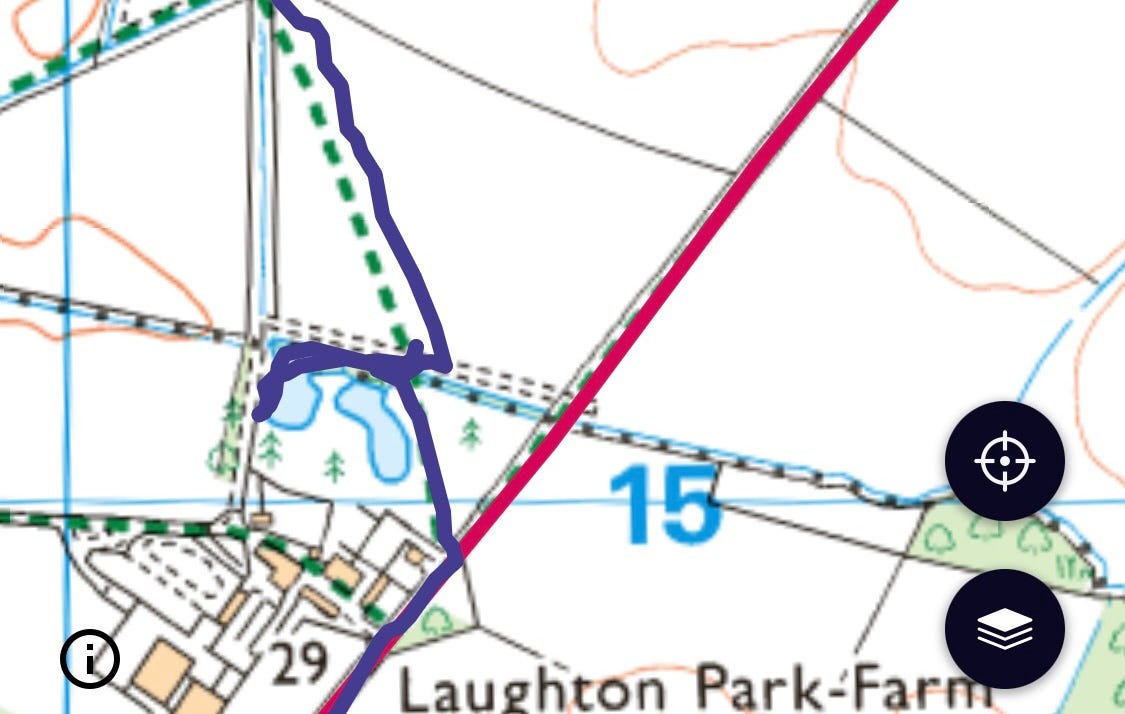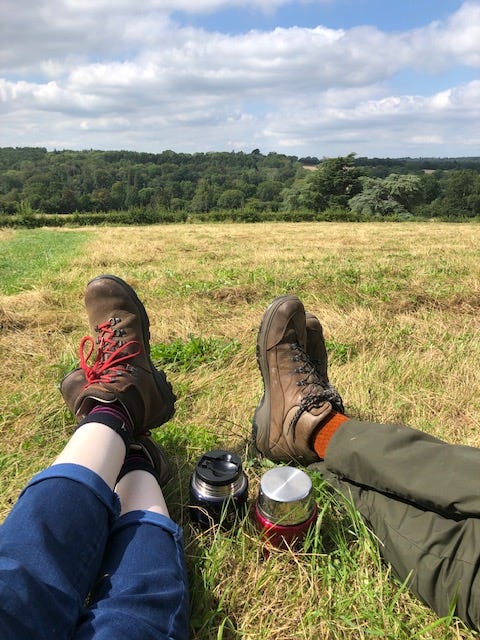Dear Reader,
With every new walk now I’m finding I can distil1 more useful information from the map than ever before. It’s now automatic for me to identify which side of a field boundary I need to be on, because I’ve learned to look closely and to exercise patience. On Ordnance Survey maps a field boundary is represented by a narrow black line, and it’s only recently that I’ve realised these innocuous markings are ones to which I hadn’t been paying proper attention.
The map – or, strictly speaking, the OS Maps app – was important for my walk today because I was on new territory. Lately I’ve been finding the local walks from my own front door to be less challenging that I’d like, and I’m getting to know some of them so well that some stretches have been lacking in the mental stimulation that I need my walks to give me. Reader, my little local walks are becoming boring.
So this morning my husband offered to drop me and my rucksack near a footpath a couple of villages away, and challenged me to walk home. Having already identified the need to broaden my horizons I set about plotting my route on the OS Maps app at the breakfast table2.
I grumbled at my husband for kicking me out of the van on a rush-hour main road, but my app soon told me to duck through a hole in the hedge just along the verge onto safer ground: a recently-harvested field of oilseed rape3.

The app is handy because it allows me to zoom in on the map. This footpath wasn’t well-trodden, and when I came to a ditch it was unclear just by looking at the landscape which side of it I needed to be on. I zoomed in and saw that I would need to step over the start of the narrow culvert and turn right, keeping the ditch on my right. After a couple of hundred metres as the ditch widened and deepened I thanked the app for telling which bank I needed to be on. Had it not, I would have found nowhere safe to cross at the shaw ahead of me where I needed to pick up my next junction.
Rebecca: 1
Getting lost: 0
I was making excellent progress, and the map was actually making sense. It’s all very well when your route is ‘just keep the sea on your left’, but with map reading – and other navigational skills, like so many things – once you’ve got some tools in your toolbelt you need to practise using them.
When you’re learning to read, make pastry or play the piano it is practice that cements the knowledge or the skill. But if all you ever practise is ‘the cat sat on the mat’, jam tarts or the National Anthem, how will you ever progress? You’ll need more challenging words, dishes and pieces to work with too, otherwise your learning will become a tedious grind with nothing new to offer. To really learn something there is little point in only repeating the familiar.
Now, new things are – by definition – unfamiliar. Even though my default mindset expects me to be able to accomplish anything – everything – immediately, my rational self knows that that’s not reasonable. I cannot expect to accomplish them (read them, bake them, play them) straight away, because they’re new, and I don’t know them.
But doesn’t that take the pressure off? YES! There is no expectation that I will succeed at something I’ve never done before!
Reader, things are looking UP…!

On the app, a long stretch of the footpath looked as if it followed a road: a narrow white strip between two black lines. I couldn’t see a road, though; nor did I want to walk along one.
I soon realised that the white strip on the map wasn’t a road, but simply the space between two field boundaries. In reality the path ahead of me ran along a bumpy embankment lined with fully-grown trees on both sides: the boundaries of the adjacent crop fields. I felt safe and secure – and not lost – as the path enticed me forwards into its haven of dappled shade cast by the trees to protect me from the late-morning sun. It was beautiful.
There was no 4G here and the OS app was struggling to pinpoint my exact location. I came across a right turn onto a new path and wondered if it was mine, but the app placed me several hundred metres shy of the turn-off I was due to take.
What should I do?
I could hear Allan, my navigation tutor, in my head.
‘Move to prove! TRAVEL TO UNRAVEL!’4
Always one to follow instructions – especially even from the voices in my head – I carried straight on. From the app I knew that a path would be coming in from the left around fifty metres after the right turn I was due to take. Reader, there it was. So the right turn had been mine: the app just didn’t have the G-juice to prove it.
But I had proved it. The system works.
Rebecca: 2
Getting lost: 0
On the right path I could sense I was near water. Aspens were rustling, the sound of their leaves disproportionate to the gentle morning breeze. A huge green four-engined dragonfly darted in front of me, leading the way with its clicking and buzzing. Just a few steps later it skipped off sideways, then flew a delightful circuit around me before heading back to where it had come from.
‘Byeeeeeeee!’ I called, sad to be losing my temporary companion.
I loved this new route, but why exactly was that, when I have always found such comfort in the familiar and enjoyed the reassurance of walking a known path to hone my landscape recognition skills?
Why was I feeling so much freer today than I ever do on my routine local walks?
It’s because I’ve stopped trying to measure up to the expectations I place on myself to just know stuff.
I’d never been here before, so I couldn’t expect to know where I was going. But I knew I needed to do the work, to use the tools, to practise the techniques I’ve been learning, and to enjoy the surprising confidence that comes with letting go and just trusting myself.
Recognising this just blew me away.
READER, I’VE GOT THIS.
Rebecca: 3
Getting lost: 0
The beautiful landscape gave way to civilisation as I found myself on a long, straight, heel-poundingly tedious concrete driveway leading to a farm. Soon an alternative route offered itself: a public footpath that would lead me across a private garden and across a farm track to another footpath on the other side. The diversion would add a couple of kilometres to my route – instead of the hypotenuse I’d now be walking the two right-angled sides of the triangle – but this was the perfect opportunity to escape that interminable driveway.
To make this detour I crossed the lawn, disturbing a flock of Canada geese which launched as one, like a raft, onto the lake. My app showed that I was on the correct trajectory for meeting up with the next path straight across the farm track I was heading for, although in real life there was no marked path across the garden.
A little planky footbridge straight ahead took me over the stream which filled the lake. And then nothing. No path, no gate, just brambles and unkempt scrub, beyond which was a deep gully and a barbed wire fence between me and my next path. No bridge across the gully. No stile across the fence.
There might as well have been a sign up: ‘YOU SHALL NOT PASS.’

There was Allan again. In my head. His ‘move to prove’ was on a loop today. I sighed and bore right, parallel to the gully, and beat my way through some of the brambles. When I found a fallen tree blocking my route altogether I turned round. I didn’t want to retrace my steps back through the garden: what if its owners saw me and identified me as the failure I obviously am?
Now that I’d turned, still parallel to the gully – and also parallel to the farm track I couldn’t get to, let alone cross – the only way I felt I could go was straight on. Still trapped in this beautiful private garden I reached a wire fence that was taller than I am. Desperate, I turned left and walked along it, now heading towards the house on the next plot.
(I hoped they didn’t have CCTV.)
There was a gate! It was padlocked, but I climbed over it surprisingly easily given the heavy guilt I was bearing from my accidental and idiotic trespass.
To find the spot that I’d hoped – pre-gate, pre-fallen tree and pre-brambles – would lead me across the farm track, I needed to turn right, then right again, and climb another gate.
(At this rate I’d end up on ‘Crimewatch’.)
The track – finally, the track – ran parallel to the gully which I’d had no way of crossing. I could even see the fallen tree I’d been unable to pass ten minutes earlier.
On my left a stile appeared: this was the continuation of the footpath I’d been looking for beyond the barbed-wire fence. And there, on my right, not even five metres past the impassable tree, was a matching stile, the stile that hadn’t been there. Beyond it was a footbridge over the gully. And beyond that, the evil twin of the planky footbridge over the stream I’d crossed earlier.
The bridge I should have taken. It can’t have been more than ten metres away from the one I had. Reader, I hadn’t even seen it.
I’ll blame the geese.
Rebecca: 3
Getting lost:whatever

The rest of my walk was an angry blur as I chastised myself repeatedly for my premature revelation earlier that I’d finally cracked it. That’ll teach me to be so smug.
I need to trust myself that with practice I will get there. My journey into not getting lost is tough, yes, but despite the mistakes I’m making it’s a challenge I’m enjoying.
I concluded that taking the pressure off myself by trying an entirely new route had been a really good step, because lowering my own expectations about how I would manage had been absolutely liberating until I’d got lost.
So imagine my delight this evening when I read Mary L Tabor’s comment on this afternoon’s post:
‘Being lost might be the best way to discover. Go for it without worry and the world will unravel.’
Mary, thank you! Soon I will have got this!
Love,
Rebecca
If you enjoyed this post, please let me know by clicking the heart. Thank you!
Will I ever learn? How do you think I’ll score next time?
Thank you for reading! If you enjoy ‘Dear Reader, I’m lost’, please share and subscribe for free.
Didn’t look right to me at first glance either, yet this is the correct British English spelling.
Buttery scrambled eggs, no toast.
Here in UK we call this bright yellow crop ‘oilseed rape’, which is harvested to produced ‘rapeseed oil’.
In some countries, the term 'rapeseed oil' is used to refer to the oil for industrial use, whereas 'Canola oil' is used to refer to the edible cooking oil. However, in the UK, 'rapeseed oil' is usually used interchangeably for both and the term 'Canola oil' is not really used at all.
(from Rapeseedoilbenefits.com)
I’d never heard the term ‘canola oil’ until I stumbled across Pioneer Woman on TV. Ditto ‘cilantro’ and ‘arugula’. We do have those over here, but we call them ‘coriander’ and ‘rocket’ respectively. And don’t get me started on biscuits (UK) versus cookies (US), or scones (UK) versus biscuits (US), because my head will spin wildly and I’ll need a lie down.
Read more about my recent training with Allan in 14. A problem with programming.






Rebecca, You made me smile, long before I got to the mention of my newsletter! This post reveals discovery, is filled with fine details and vulnerability. The writer at work! Kudos and 💕. --Mary
Brilliant piece, this, Rebecca.
Regarding footnote one- the correct British English spelling aka the correct spelling. Don't let the fact that the internet is spiritually American colour your flavour, you know?